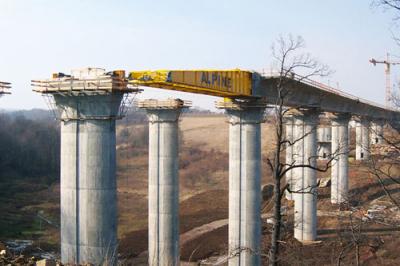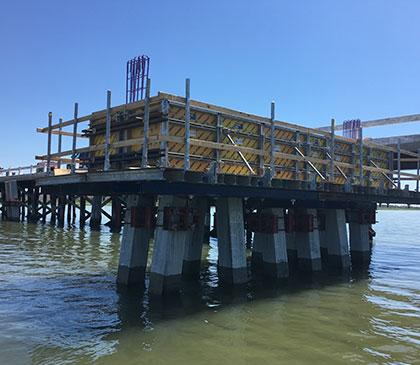Formwork solutions for bridge construction
Understanding how to bridge obstacles.

Doka is firmly committed to building its lead in formwork-technology. This is the reason it continues developing measures to boost construction efficiency and putting them into practice systematically. Firstly in formwork systems, and secondly in the technical services to go with them. Doka formwork solutions always come as a package that delivers tangible benefits and added value to our customers. We have a client-orientated mindset and 'build bridges' to our customers' goals.
As a pathbreaking formwork manufacturer, we take an all-encompassing view of the construction sequence. Formwork planning and formwork statics are just as much a part of our spectrum of services as are on-site assembly and subsequent formwork return. Only an end-to-end formwork concept will deliver the best results. The mere fact of dealing with just one partner for formwork ensures that the interfaces are well co-ordinated.
We successfully accompany you all the way through your construction project.
- result(s):
- result(s):
![Doka UniKit]()
Doka UniKit - the universal engineering kit for heavy loads in the infrastructure sector. Whether for bridge, tunnel or ...
![Bridge formwork ParaTop]()
The ground-support-free cantilever arm formwork for steel-composite and pre-cast concrete bridges
No results found. The search covers names of Doka products and services.
_Understanding requirements
The bridge from knowledge to experience
Our capabilities span far and wide. We focus on the formwork-engineering challenges right from the design phase. Even at this early stage, we start contributing our knowledge so that the works can be carried out swiftly, efficiently and economically. We bring much more to the table, still: a solution in form of the right formwork system.


Pylons and piers
Piers decrease the width of the superstructure support centres between the abutments, thereby permitting a lower overall height. They mostly take the form of single or paired piers. On cable-stayed or suspension bridges, the central support takes the bridge loads, which are suspended from it. This is referred to as a pylon. They basically take the form of self-supporting pylon towers, A or H pylons or portal pylons.
Your benefits with Doka
Our extensive planning expertise and high-performing crane-climbed and automatic climbing formwork systems can handle great variability in the design of piers and pylons, regardless of geometry, height and dimensioning.
Shoring towers
If the superstructure of a concrete bridge is not far above the ground, it can be constructed cost-effectively and efficiently using falsework. Falsework is an auxiliary construction used for holding building materials and systems in shape, particularly in the field of concrete bridge construction. On multispan bridges, the superstructure is mostly cast a section at a time using a single falsework construction.
Your benefits with Doka
Cost-effective planning and on-time delivery of materials-optimised shoring scaffolds for transferring high loads from bridge superstructures safely and economically.


Cantilevering
The bridge sections are cast one after the other by a pair of cantilever forming travellers that work outward from a pier (pier head) and carry the formwork, rebar and the weight of the fresh concrete. In most cases, this takes place more or less symmetrically to either side of the pier. The casting sections are generally between 3 and 5 m long.
Your benefits with Doka
Outstanding cost-efficiency and rapid equipment availability, made possible by Doka's rentable all-in-one system. Also, high certainty regarding planning and execution, thanks to thorough project support from Doka, taking in everything from detailed planning to co-ordination with the superstructure designer to on-site support by the Competence Center for Cantilever Construction.
Composite bridges
Put in simplified terms, the longitudinal steel girders of the bridge are connected to the CIP concrete deck slab by means of shear connector studs so as to obtain a shared (i.e. 'composite') load-bearing effect. Having the longitudinal bridge girders prefabricated at the plant will result in a significantly reduced construction period. The composite technique delivers low-cost, durable, low-maintenance bridge-deck solutions, the reason it is used for structures ranging from small overpasses to large viaducts.
Your benefits with Doka
Cost-effective solutions for widely differing bridge geometries are achieved by using rentable, variable, all-in-one systems and the comprehensive project support provided by the Composite Bridge Competence Center.


Formwork for Movable scaffolding system
Doka offers high-quality formwork systems suitable for Movable scaffolding systems of various providers. In our company, we have many years of experience in project-specific formwork planning and the pre-assembly of our formwork solutions. Together with partners, we find well thought-out solutions that complement our range.
The use of Movable scaffolding systems is particularly advantageous in the construction of multi-span prestressed concrete bridges, when crossing deep valleys, at hard-to-access construction sites such as nature reserves or waterways, as well as for bridging traffic routes. The piers are constructed in advance.
For example, with the Large-area formwork Top 50, the spacing of the girders, steel wall ties, and anchor positions can be adapted to project-specific requirements depending on the geometry of the scaffolding.
Incremental launching
The continuous superstructure is cast a section at a time behind an abutment in an on-site fabrication area referred to as "casting yard". Each section cast there (i.e. each "cycle") is "pushed" across the piers, together with the previously cast sections, to make space for casting the next section. This method is most often used on longer bridges with straight or near-circular ground-plans and with uniform summits or sag-curve radii in the front elevation.
Your benefits with Doka
Project-specific planning and pre-assembly of adjustable formwork systems for casting-yard construction, with practical formwork closing/opening logic for time- and cost-optimised workflows.


Arched bridges
The arched bridge is surely the most visually impressive constructional bridge design. Particularly when it comes to crossing deep ravines, arched bridges are the preferred design. The most common construction methods are cantilevering and conventional falsework. An alternative technique here is the lowering-arch or "swivel-in" construction method.
Your benefits with Doka
Extensive planning services, and rentable formwork solutions that can be specifically tailored to the statics of each superstructure, for optimised load transfers and ensuring that the project progresses to plan.
Discover more formwork solutions
Contact for large-scale projects
Working together closely makes it possible to decide on a solution for your complex bridge project. Your requirements are discussed with Doka experts as early as in the project development phase, influencing its success from an early stage. Tap into the know-how accumulated from numerous successfully executed bridge projects.





















